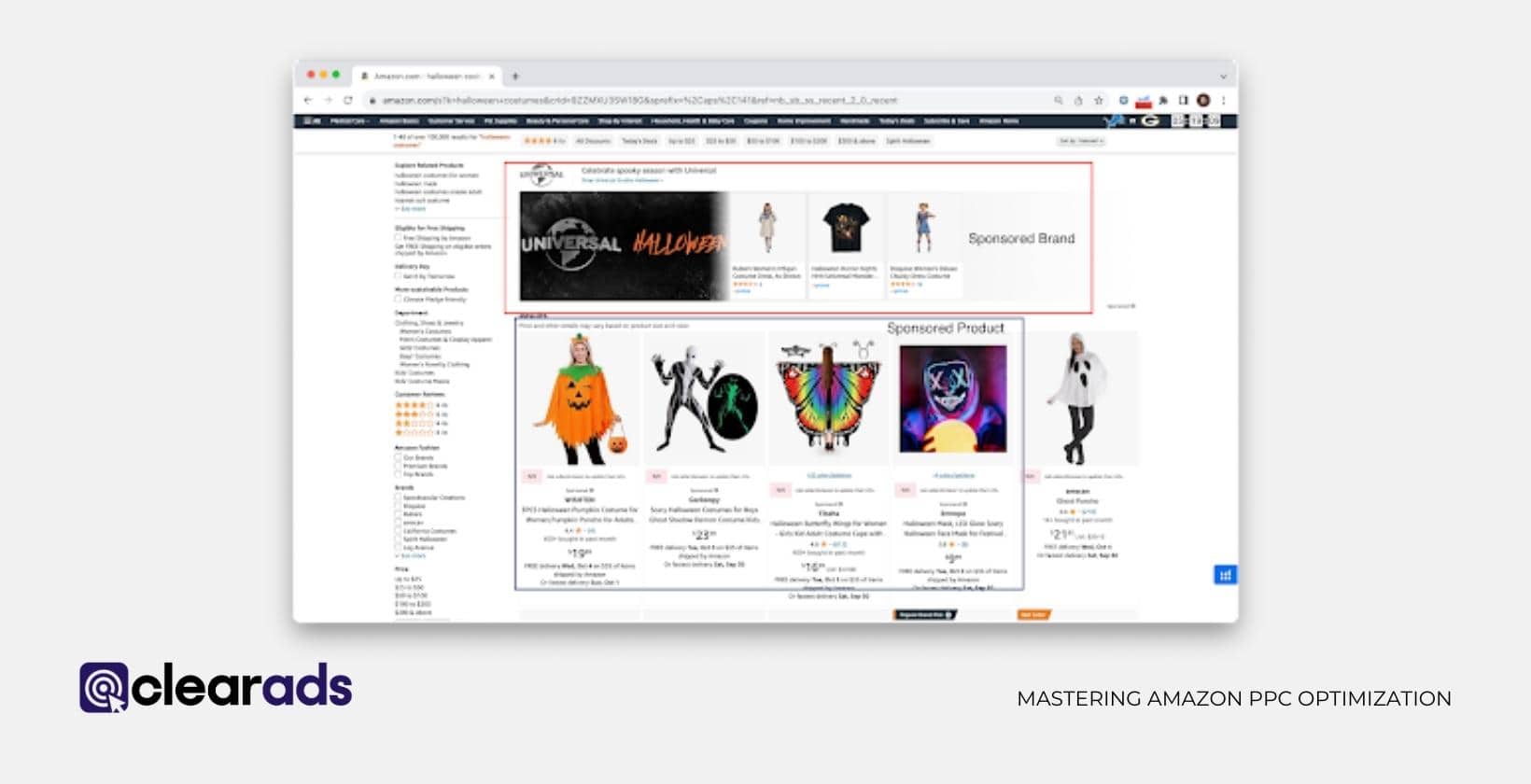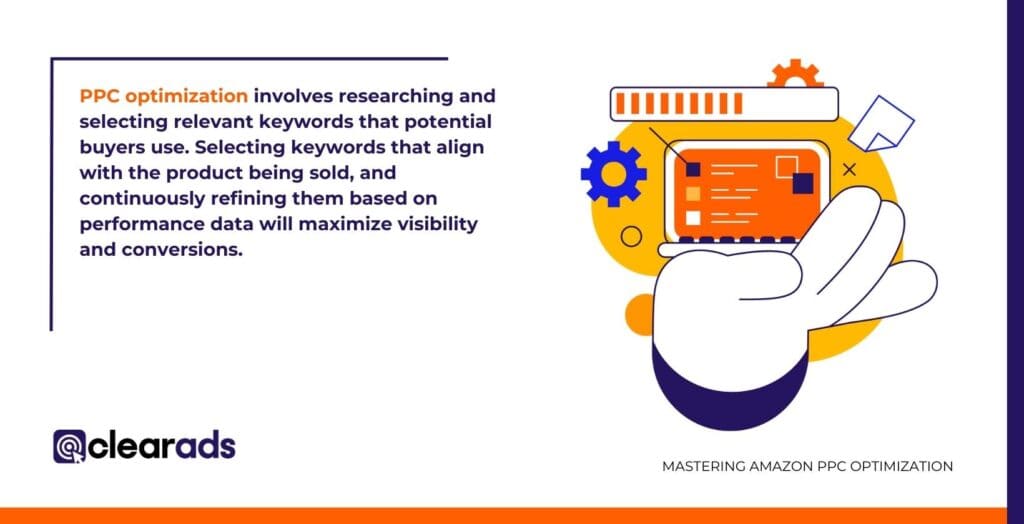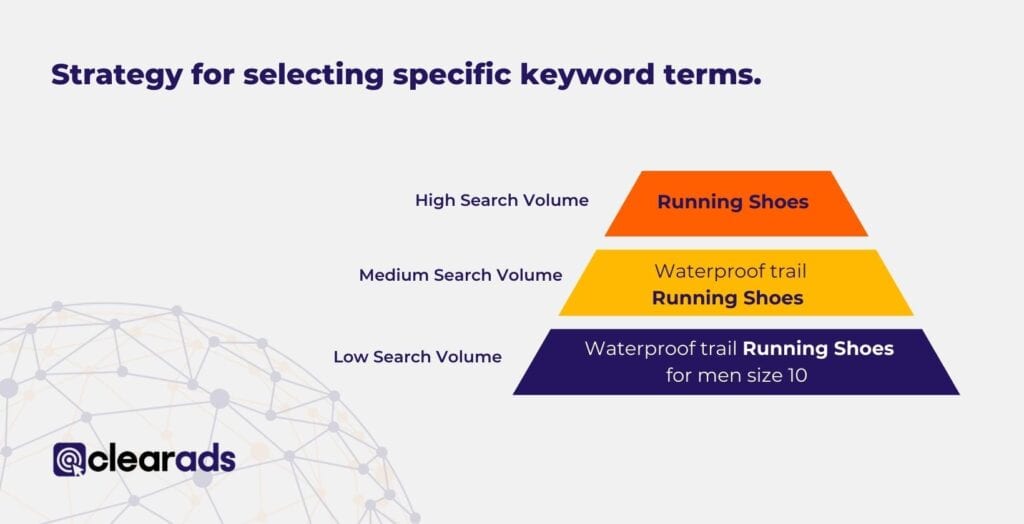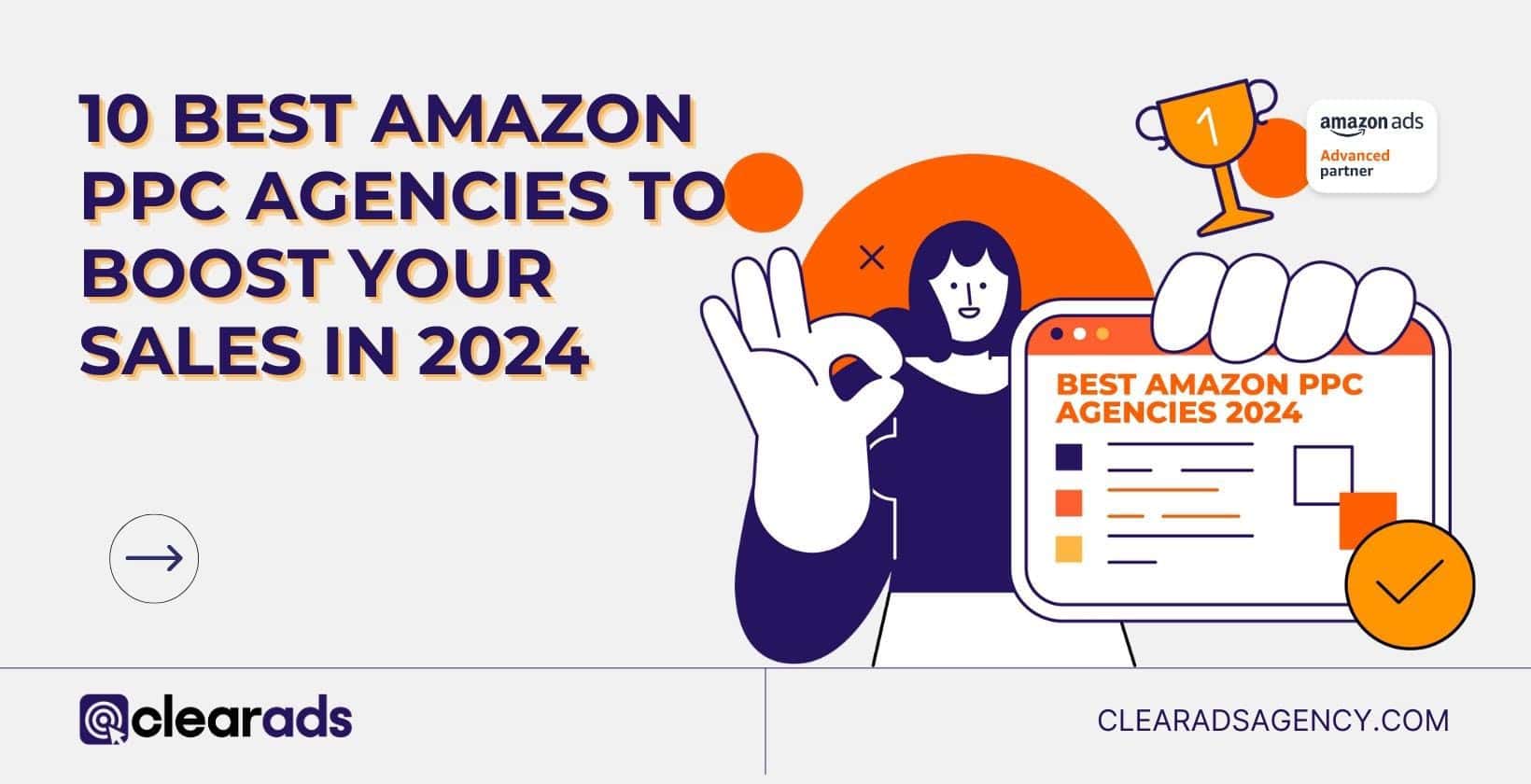Mastering Amazon PPC Optimization:
20 Effective Techniques for Boosting Sales and Visibility
- Post Published:

Amazon’s advertising platform has evolved into a sophisticated tool, offering sellers a multitude of techniques to perform PPC optimization of their campaigns and maximize profits. From its early days as a straightforward platform for product listings, Amazon Ads has transformed into a comprehensive advertising ecosystem, providing a suite of powerful tools and features designed to maximize product visibility, drive traffic, and ultimately, boost sales.
Amazon PPC is a critical component for sellers to increase product visibility and sales.Sellers can optimize their campaigns by adjusting bids, pausing keywords, negating keywords, and more. Bidding strategies on Amazon, from ‘Fixed Bids’ to ‘Dynamic Bidding’, offer sellers varying degrees of control over their ad spend, ensuring optimal placement and maximizing return on investment. Specialized ad types on Amazon, such as Sponsored Product Ads, Sponsored Brand Ads, and Sponsored Display Ads, offer sellers tailored advertising solutions to boost product visibility, drive traffic, and optimize conversions. Continuous refinement in Amazon PPC optimization involves consistent monitoring using various Amazon reports, leveraging analytics to interpret user interactions and ad effectiveness, and making iterative, data-driven adjustments to improve campaign performance over time.The future of Amazon PPC optimization lies in technological advancements, leveraging AI and external tools to enhance data analysis, ad adjustments, and predictive strategies, ensuring sellers achieve superior advertising outcomes.
Introduction to Amazon PPC Optimization Techniques
Amazon PPC optimization techniques enhance campaign effectiveness, direct targeted traffic, and optimize Return on Investment (ROI). Optimization techniques range from keyword strategies to refining ad content, to insightful analytics. This guide will provide detailed strategies to optimize your Amazon PPC campaigns.
What is Amazon PPC Optimization and How Does it Elevate Campaign Success?
Amazon PPC optimization is the process of refining PPC campaigns to elevate performance and efficiency. PPC optimization elevates campaign success by increasing visibility, maximizing return on ad spend, and enhancing overall sales and profitability.
Optimization involves refining these advertisements to enhance their performance. This includes selecting the right keywords, setting appropriate bids, and structuring campaigns efficiently. Successful optimization reaches the most relevant audiences and effectively allocates budgets.
Optimized ad campaigns will achieve greater visibility in Amazon’s busy marketplace. With millions of products listed on Amazon, standing out is a challenge. PPC campaigns place products in prominent positions in the search results. This elevated visibility translates to increased sales, leading to better ranking, organic sales, and profitability.
A well-optimised PPC campaign will also yield a better return on investment (ROI). By ensuring that ads are seen by the most relevant audience, there’s a higher likelihood of conversion. Over time, continuous optimization would lower the cost per click (CPCs), while maintaining or increasing sales. This results in a more effective and profitable campaign.
An effective campaign is not merely about running ads; it’s about running them smartly. Optimization is a meticulous process of adjusting and refining, so every dollar spent on advertising brings the maximum possible return.
Foundational Amazon PPC Optimization Strategies
Lorem ipsum dolor sit amet, consectetur adipiscing elit. Ut elit tellus, luctus nec ullamcorper mattis, pulvinar dapibus leo.
Optimize campaigns by adjusting bids, pausing keywords, negating keywords, and more. Below you will find 20 ways to optimize your PPC campaigns, split into 2 sections:
Before Campaign Creation:
-
- Keyword Strategy: Use tools like Helium 10 or Jungle Scout to conduct in-depth keyword research. Make sure you’re hitting all possible keywords in the sales funnel (root keywords, longtail keywords, semantic keywords).
- Competitor Analysis: Extract insights from competitors’ strategies to identify potential gaps and opportunities. Check what keywords they’re ranking for by using Helium10’s cerebro, and see what they’re bidding on.
- Ad Scheduling: Find the most active periods for your target audience to maximize ad visibility and build a strategy PPC strategy around that. There are many tools out there to help you with this, such as ScaleInsights or Pacvue.
- Budgeting: Establish clear daily or monthly budgets to maintain spending within desired limits. This will allow businesses to figure out how much they’re willing to spend if the campaigns don’t perform as expected.
- Ad Placement Familiarization: Understand Amazon’s placement options to strategically position your ads. The combination of placements you use will be determined by your campaign goal. Below is an example image of Sponsored Product and Sponsored Brand placements:
- Campaign Strategy Drafting: Decide on the mix of Sponsored Brands, Sponsored Products, or Sponsored Display campaigns based on your products and target audience. Define which keywords to target for the respective campaign type.
- Campaign Planning: Segment campaigns by product type, brand, or other criteria for more targeted advertising. Avoid overcrowding one campaign with several ad groups. This allows seller to analyze more precisely in the future.
- Feedback Integration: Incorporate commonly mentioned product benefits or features into your initial ad strategy with Sponsored Brand ads.
- Landing Page Preparation: Optimize product listings with high-quality images, comprehensive descriptions, and compelling CTAs to ensure a higher conversion rate once the campaign starts.
- Initial A/B Testing Plans: Draft strategies to test variations of ad creatives, from Sponsored Brand images to main images on your listing.

After gaining data:
- Bid Adjustments: Continuously adjust bids based on keyword performance, placement, and ROI. For example, if visibility is the goal, then getting as many Top of Search (TOS) impressions as possible warrants an aggressive bidding strategy.
- Modifier Fine-tuning: Adjust TOS and Product Page (PP) modifiers based on ad placement performance and goals.
- Dynamic Bidding: Use dynamic bid adjustments to remain competitive in real-time auctions. Sellers may realize that ‘Dynamic Down Only’ bids aren’t quite getting the same impressions as ‘Fixed Bids’ with a TOS modifier. Adjusting the bid types accordingly can improve campaign performance.
- Keyword Refinement: Incorporate, pause, or negate keywords based on performance data. Use search term reports or look at the search term tab within your campaign to help define these keywords.
- Budget Re-allocation: Shift budgets to campaigns showing the best ROI.
- Performance Monitoring: Regularly check PPC metrics like CTR, Conversion Rate, and ACOS (Advertising Cost of Sale) to ensure campaign effectiveness.
- Continuous A/B Testing: React on your A/B test results. Sellers often forget the tests they are carrying out in their campaigns and just leave their campaign as originally set up.
- Placement Optimization: Review and adjust bids for specific placements based on data-driven performance insights.
- Leverage Product Targeting: Focus on specific ASINs or categories that are proving successful. Use the fact that products get a larger ranking boost through product targeting campaigns to your advantage.
- Monitor ACOS: If the ACOS exceeds desired targets, revisit and adjust strategies accordingly. For example, if your ACOS is low, then consider a more aggressive campaign.
It is vital that sellers set a clear goal for their campaign before it has started running. This will be vital when considering how to optimize and will keep you focused. It is easy to have fluctuate the optimization based on the live results, but this is an ineffective strategy. Stick with a goal.
Setting Clear Business and Campaign Goals
Clear business and campaign goals serve as a roadmap that steers every decision made within a campaign, ensuring alignment with overarching business objectives.
If an objective is to increase brand awareness, their PPC campaign might prioritize maximizing impressions and reach. Conversely, if the objective is sales-driven, the campaign could emphasize conversion rate and sales volume. Going into PPC without a real goal will lead to unprofitable selling or a lack of clarity on how PPC affects a business. It will also take longer for much progress to be seen.
Well-defined goals keep Amazon PPC campaigns sharply focused. To illustrate, let’s consider a company launching a new product on Amazon.
If their goal is rapid market penetration, they might opt for aggressive bidding on high-traffic keywords to quickly capture market share. For example, bidding aggressively on high search volume keywords, whilst also using Top of Search (TOS) modifiers, and simultaneously running Sponsored Brand ads. This will ensure products appear as often as possible on the Search Engine Results Page (SERP).
A profitability target would hone in on niche, high-converting keywords to ensure a better ROAS. In this case, opt for a less aggressive bidding strategy and target longtail keywords rather than the main one.
Goals and PPC Metrics
Business goals will determine which PPC metrics an advertiser will focus on. For example, brand visibility would focus on metrics such as impressions, CTR, and ad position. A business aiming for sales growth would monitor metrics like conversion rate, total sales, and ACOS.
By aligning PPC metrics with business goals, sellers ensure that their campaigns produce actionable insights that drive business growth.
Why is Structuring Your Campaigns Properly Essential for Optimization?
A clear account structure provides a targeted approach when advertising products.
Structuring the account properly will improve the accessibility of the campaign for more effective optimization. It also gives third party advertisers easy access to the goal and targeting of each campaign within the account. Giving them a solid foundation to make necessary changes.
All of the necessary details should be conveyed at the campaign and portfolio levels without the need to dive too deep into the campaign. For example, is it a Sponsored Brand Video campaign using exact-match keywords that direct shoppers to the storefront? By having clear structures it streamlines the optimization process. Negating any confusion in the process.
Granular Campaign Structures:
A granular campaign structure allows for more budget control. The granular approach allocates budget strategically for different products and strategies. This structure will prevent overspend in the less profitable areas of an account. Budget can be allocated to individual keywords that are driving your revenue by having campaigns dedicated to a single keyword.
Strong Portfolio Structure:
A strong portfolio quickly identifies pain points and opportunities within an account. Consider a portfolio structure that is set apart by goals like discovery campaigns, profitable campaigns, and launch campaigns etc. Each of these is likely to have a different Key Performance Indicator (KPI) target and expectations.
Depending on the size of the account, each of the portfolio goals could be expanded further by product category or even individual ASINs. Seasonal portfolios are an option for products with seasonal variability like Christmas decorations.
Naming Structures:
Having an organized naming structure for your campaigns is vital for several reasons:
- Efficiency in Monitoring: A systematic naming convention provides clarity and allows for easier tracking. For instance, a name like “WinterShoes_Auto_2023” instantly informs you about the product, the campaign type (automatic), and the year it’s running. Without diving deep, you understand the campaign’s core elements.
- Use any format that provides clarity to the campaign, consider identifying manual and automatic campaigns within the naming convention for greater identification.
- Ease of Reporting: When pulling reports, a clear naming structure ensures that data is easily segmented and analyzed. This becomes particularly beneficial when handling multiple campaigns or sharing data with stakeholders.
- Avoiding Duplication: A consistent naming system prevents accidental replication of campaigns, ensuring resources are not wasted.
An example of this could be including the letter “E” for Exact match or “FIX” for fixed bids. I.e.
“Runningshoes_SP_E_FIX_SKW_TOS”
This is what decipher from that campaign name:
- It’s for the product running shoes
- It’s a Sponsored
- Product campaign
- It uses Exact match
- It uses ‘Fixed Bids’
- It is a single-keyword campaign
- There is a TOS Modifier on the campaign
Avoid Overcrowded Campaigns:
Overcrowding campaigns, or adding too many products or keywords into a single campaign, can dilute the campaign’s focus and hinder its performance. Here’s why it’s detrimental:
- Budget Dilution: With multiple products in a single campaign, the allocated budget gets distributed among all the products. This can starve top-performing products of necessary ad spend, potentially reducing their visibility.
- Inefficient Targeting: Multiple products often cater to slightly different audiences. By overcrowding, you risk showing the wrong product to the wrong audience.
- Difficulty in Analysis: With a diverse product range in one campaign, pinpointing what’s working and what’s not becomes challenging. If one product performs exceptionally well while another underperforms, the aggregated data can present a misleading average. You can gather this information by deep diving into the campaign but it is not suited for a quick glace.
- Lopsided Spend: Sellers will find that some keywords are taking up a much larger percentage of the daily spend than others.
Importance of Having Separate Campaigns for Different Product Categories:
- Focused Targeting: Each product category often appeals to a distinct customer segment. By having separate campaigns, you can optimize ad copies, keywords, and bidding strategies to resonate with the specific target audience.
- Optimized Budget Allocation: With distinct campaigns, budget allocation becomes strategic. High-performing categories or those with higher margins can be allocated more budget to maximize returns.
- Clear Performance Metrics: Separate campaigns allow for cleaner data interpretation. Understanding which category is driving sales, what needs improvement, and which might require a different strategy becomes straightforward.
Seasonal Adjustments:
Some product categories might have seasonal peaks. For instance, beachwear might peak in summer while winter jackets in colder months. Having separate campaigns allows for flexibility in adjusting bids and budgets in line with seasonal demands.
Clear business goals will determine the structure of Amazon PPC campaigns. A well-structured campaign ensures clarity, efficient resource allocation, and a streamlined path to achieving set objectives.
The Art of Keyword Selection in Amazon PPC Optimization

PPC optimization involves researching and selecting relevant keywords that potential buyers use. Selecting keywords that align with the product being sold, and continuously refining them based on performance data will maximize visibility and conversions.
Selecting the right keyword targets is crucial for building an organic ranking that sticks. Organic ranking determines the long-term effectiveness of a campaign. Bidding highly on ranking for competitive terms with high search volumes is a common mistake. As soon as advertisers pull back spend for these terms, if conversion rate was never strong, the ranking will plummet.
Strategy for selecting specific keyword terms.
Identify terms that include keywords that you want to rank for with a lower search volume.
For instance, instead of using a broad term like ‘running shoes’, focus on a specific long-tail keyword like ‘waterproof trail running shoes’. This term will be less competitive so it will cost you less for a conversion. As you build convertons for this term in comparison to your competitors, you will see the ranking flywheel start to take effect.
Because the ideal term ‘running shoes’ is included within it, it will still positively impact your ranking in a slower, sustainable manner.
Below is a visualization of how this works:

Using tools for keyword discovery.
Helium 10 is a tool that can assist with finding these relevant terms. Ensure that well-converting terms run through your whole account. This includes the back end, title, bullets, and A+ content. Check for new terms consistently and use reporting such as search term reports to check performance at least once a week.
Reducing Wasted Ad Spend with Negative Targeting
Reduce unnecessary spend on ads by removing terms with clicks and zero orders. Terms with low conversion rates or a high ACOS should moved into the negative targeting section. These terms can negatively impact ranking and burn a hole in your advertising budget. Instead use them as a negative targeting strategy for a more precise campaign.
Decreasing Unnecessary Ad Spend
Check the ‘search term’ tab within each campaign to ensure that broad and phrase match terms and autos are not targeting irrelevant keywords. This search term tab provides insights into which keywords are driving clicks but not converting into sales. By adding these non-converting terms to the negative keyword list, sellers can prevent their ads from showing up when these terms are searched, thus saving on unnecessary costs.
If a keyword isn’t performing but is still very important to your product, then decrease the bid instead of immediately pausing it.
Why is monitoring broad and phrase match terms crucial?
Broad and phrase-match keyword types in Amazon PPC campaigns provide advertisers with the flexibility to reach a wider audience. These match types display ads for search terms that are similar to the selected keywords. This is beneficial for keyword research and expanding audiences, but it could appear for unrelated or irrelevant search terms.
For instance, a “stainless steel water bottle” using a broad match keyword type, may appear for search terms like “stainless steel flask” or “water bottle holder”. While these terms might be related to the terms, they are not relevant to the specific product.
Through consistent monitoring of broad and phrase match keywords, sellers will identify and negate unprofitable terms, so ads are displayed only for the most relevant and potentially profitable search queries.
Another method to avoid this is through a broad match modifier. If this match type is still necessary, advertisers can use a broad match modifier to prevent the ad appearing on irrelevant results pages. The key terms are indicated using a “+” sign before it, to identify that the keyword needs to be part of the search query.
How to ensure a campaign is strictly unbranded?
Unbranded campaigns target customers who are not looking for a brand but are interested in a product category or type. Unbranded campaigns reach a broader audience and attract shoppers without a brand loyalty.
An unbranded campaign will negate brand-specific terms. For instance, for a product like “running shoes”, negate brand-specific searches like “Nike running shoes” or “Adidas runners”. Negating the product ASINs or brand name ensures that the campaign remains unbranded and focused on the product type or category.
Advanced Amazon PPC Optimization Techniques
Three advanced optimization include fixed bids, dynamic bidding, and placement bids. These techniques offer greater degrees of control over ad spend and placements to maximize return on investment. Understanding each strategy, will give a foundation for effective campaign optimization based on desired outcomes, historical data, and market dynamics.
Three advanced optimization techniques:
- Fixed Bids: Sets a static bid amount for an Amazon advertising campaign, providing consistent and predictable bid management.
- Dynamic Bids: Allows bid adjustments based on factors like placement, device, and audience, enabling more flexible and responsive campaign optimization.
- Placements Bids: Specify bid adjustments for specific ad placements, allowing for targeted optimization of your ad placements on Amazon.
Bidding Strategies: Aligning with Your Target ACOS
Setting a target ACoS is an effective measure to dictate the performance of a campaign given its desired goal. ACoS represents the ratio of ad spend to targeted sales and is calculated as follows: (ad spend / ad sales) x 100
Assessing ACoS indicates if advertising spending is yielding a positive return on investment. For instance, if a product’s breakeven ACoS is 30% and the ACoS is set at 25%, it means that for every sale generated by the ad, the seller will be making a sale at a profit. It should be noted that there are numerous factors that can affect ACoS, and viewing this should not the the sole indicator of a successful campaign.
It is equally important to assess the campaign’s conversion and impression rates as a higher ACoS does not always indicate a failing campaign.
Working Out Your Max CPC and Choosing a Bidding Strategy
Max CPC represents the highest amount a seller is willing to pay for an ad click. Determining this requires understanding your profit margins, conversion rates, and target ACOS. For example, if a seller has a conversion rate of 10% and a target ACOS of 25% for a product that sells for $20, the Max CPC would be calculated as:
Max CPC = (Product Price x Target ACOS/100) x Conversion Rate
Given the values provided:
Max CPC = ($20 x 25/100) x 10% = $0.50
Choosing a Bidding Strategy:
Depending on the campaign goals, it’s important to choose a bidding strategy for your keywords. Here is a list of bidding types that sellers have at their disposal.
- Fixed Bids: Sellers set the bid, and Amazon doesn’t change it. It’s the most aggressive bid but is ideal for ranking campaigns.
- Dynamic Down Only: Amazon can lower the bid if a sale seems unlikely. Prevents overpaying for non-converting clicks.
- Dynamic Up & Down: Amazon can increase or decrease the bid based on the likelihood of conversion. This strategy is more aggressive and can lead to higher visibility, but it also might result in higher CPCs.
What Role Does Placement Play in Amazon PPC Optimization?
Placement in Amazon PPC Optimization dictates where an advertisement appears on a search results page or on a product listing. The placement of an ad has a direct impact on the chances of being seen and clicked by potential buyers.
Ads appearing higher in the search results gain more attention than those positioned lower or on subsequent pages. Users won’t scroll excessively far or navigate to subsequent pages unless they are not finding what they’re looking for. Therefore, securing a top placement can lead to increased click-through rates and sales.
Amazon has made it easy to adjust bids for these prime slots, as you can now bid a percentage to appear on page 1 or on similar listings.
An example of this:
Imagine an advertiser places a bid of $1 for the keyword “running shoes.” They want to increase their chances of their ad appearing at the Top of Search (TOS), which is a prime slot for more visibility. To achieve this, they decided to use Amazon’s feature to adjust their bid by an additional 50% for the TOS placement.
Original Bid: $1 for “running shoes”
Adjustment for TOS/Product Pages: 50% of $1 = $0.50
If Amazon determines that placing the ad at the Top of Search is beneficial, the total cost for that placement would be:
Total Bid for TOS Placement: $1 (original bid) + $0.50 (adjustment) = $1.50
Therefore, for the TOS placement, the advertiser is willing to pay up to $1.50, ensuring a better chance of securing that prime position for their ad.
The principle is the same for product page modifiers.
The “Placement” option in Amazon’s Campaign Manager provides advertisers with a clear view of ad performance based on its placement. This data can be crucial in decision-making. For instance, if an ad gains significantly more sales when placed at the top of search results compared to product pages, it may be beneficial to adjust bids accordingly.
It is now possible to appear in the ‘Rest of Search’ area, but you will need API to action any changes here.
6 Strategies to maintain optimal placement on Amazon search results:
- Continuous Bid Optimization: Regularly review and adjust bids based on performance metrics. If a keyword is performing well and driving sales from a top placement, consider increasing its bid to secure that position.
- Utilize Placement Modifiers: Amazon allows sellers to increase bids for top-of-search and product page placements. Utilizing this feature can ensure that ads appear in these prime positions more often.
- Monitor Placement Reports: The placement report provides insights into where ads are showing and how they’re performing in each position. Based on this data, adjustments can be made to bids and strategies.
- Refine Targeting: Ensure that the targeted keywords are relevant to the product being advertised. Irrelevant keywords might win a top placement but may not convert well.
- Dynamic Bidding: Dynamic bidding automatically adjusts bids in real-time. This feature can raise bids (up to a set percentage) for placements that are more likely to convert and lower bids for less likely placements.
- Budget Allocation: Ensure that campaigns with the best-performing placements have an adequate budget. Running out of budget mid-day can lead to lost opportunities for prime placements.
How Can Market Analysis Further Refine Your PPC Optimization?
Market Analysis can refine your PPC optimization by identifying which competitors or terms to target. Market analysis is not merely about understanding who the competitors are but also about discerning their strengths, weaknesses, and marketing strategies. Competitors become effective targets, and stealing a sale from a competitor’s page, can give you a 4x rank boost.
By analyzing competitors, sellers can:
- Identify high-performing keywords that competitors are targeting.
- Discover promotional strategies that competitors are using to boost sales.
- Recognize pricing strategies that resonate with the target audience.
If a competitor is consistently ranking high for a particular keyword consider targeting the same term, provided it’s relevant to the seller’s product.
3 Strategies for targeting competitors effectively:
Targeting competitors in PPC campaigns is a fruitful strategy when executed correctly. Some effective tactics include:
- Product Targeting: Targeting competitor ASINs directly in Sponsored Product campaigns will allow a seller’s product to appear on the competitor’s product page. This strategy can be especially effective if the seller’s product has competitive advantages, such as a lower price or better reviews.
- For greater brand visibility, target competitor product pages with a Sponsored Brand campaign including high quality images or video.
- Negative Keywords: Negative keywords are used to prevent your ads from being triggered by unprofitable terms or phrases. Negate terms with a significant brand reputation unless you have the budget to bid against them.
- Analyzing Competitor Reviews: Act on the responses from customers about product features and customer service. Both positive and negative reviews provide valuable information to address on PDPs or in manufacturing. Amazon considers customer satisfaction as the utmost important part of their service, so listen to what the consumer wants.
In combination with other PPC strategies, market analysis significantly enhances campaign optimization. Through an understanding of shopping behaviours and competition, sellers can position products effectively for a better ROAS.
The Power of Dynamic Bidding in Amazon PPC Optimization
Dynamic Bidding provides control over bidding optimization in real time. Dynamic Bidding is offered by Amazon and involves modifying bids based on the conversion probability of each auction. This bidding structure is flexible and takes advantage of each potential click, but could lead to overspending as it is automatically adjusted.
Fixed bids give you complete control over the bid, as this can’t be manipulated by Amazon. Fixed bids are great for campaigns with an aggressive bidding strategy like ranking campaigns. This avoids Amazon reducing your bids or increasing them higher than you are comfortable spending.
Example: Let’s say you set a Fixed Bid of $2. Regardless of the auction dynamics or how competitive the keyword becomes, the bid will remain at $2. This prevents any overspending, even if competitors are bidding at higher rates.
Dynamic Down Only:
Dynamic Down Only gives Amazon permission to decrease bids in an auction if the click is unlikely to result in a conversion based on historical data. This method is cost effective as sellers conserve their budget through not overpaying for clicks that wont result in a sale. This wouldn’t work for campaigns with a new product as there is a lack of historical data and sellers will want to bid aggressively for more visibility.
Example: If you set a bid of $3 for a product, and based on historical data, Amazon predicts a low conversion rate for a particular auction, your bid might be dynamically reduced to, say, $2.
Benefits of Dynamic Up & Down bidding.
Dynamic Up & Down bids also allow Amazon to increase your bids if they think that the click is likely to lead to a conversion based on past data. This strategy ensures you remain competitive in auctions where the likelihood of conversion is high.
Example: For a keyword with a set bid of $2, if Amazon’s algorithms predict a high chance of conversion for a specific auction, your bid might be increased to $2.50, boosting your ad’s chance of winning the auction and appearing in a prime spot.
Diving Deeper: Specialized Ad Types and Their Optimization
The three specialized ad types on Amazon, are Sponsored Product Ads, Sponsored Brand Ads, and Sponsored Display Ads. Specialized ad types offer tailored advertising solutions to boost product visibility, drive traffic, and optimize conversions. These ad types, combined with strategic optimization techniques, effectively target specific audiences, enhance brand presence, and maximize return on advertising spend.
The Potential of Sponsored Product Ads
Sponsored product ads drive traffic directly to the product detail pages, capitalizing on Amazon’s vast customer base. Most direct sales come through Sponsored Product ads, which make them beneficial for product launches and sales targets.
4 Advantages of Sponsored Product Ads:
- Visibility: Sponsored Product Ads prominently display products at the top of and within Amazon’s search results or on PDPs, to quickly capture the attention of customers.
- Targeted Reach: Sellers can target specific keywords or phrases. This ascertains that ads are displayed to interested audiences.
- Pay-per-Click Model: PPC advertising is a cost effective solution as advertisers are charged only for click on an ad.
- Sales and Ranking Impact: Sponsored Product Ads not only drive direct sales but also influence organic ranking on Amazon. The increased sales velocity from these ads can enhance a product’s organic search rank, leading to further organic sales.
3 Use-Cases for Sponsored Product Ads:
- Product Launches: When introducing a new product to the market, these ads can quickly generate visibility and initial sales.
- Competitive Niches: In categories with high competition, Sponsored Product Ads can differentiate a product and ensure it doesn’t get lost among numerous similar listings.
- Seasonal Promotions: For products with seasonal demand, these ads can be ramped up during peak seasons to capitalize on increased search volume.
Best Practices for Optimizing Sponsored Product Ads:
- Keyword Research: Utilize tools like Helium 10 or SellerApp to identify high-performing and relevant keywords for your product.
- Bid Optimization: Regularly review and adjust bids based on performance. If a keyword is generating sales at an acceptable ACOS, consider increasing the bid to capture more impressions.
- Ad Placement: Monitor where your ads are appearing and adjust bids to target top-of-search placements when they prove to be profitable.
- Negative Keywords: Regularly review search term reports and add irrelevant or non-converting search terms to the negative keyword list to reduce wasted ad spend.
- Product Listing Optimization: Ensure that the product listing linked to the ad is fully optimized with high-quality images, compelling descriptions, and relevant keywords. A well-optimized listing can increase the conversion rate of the traffic driven by the ads.
Sponsored Product ads can directly impact a product’s organic rank on the platform. As sales velocity increases through these ads, a product’s position in organic search results will improve significantly, producing a flywheel effect. The flywheel takes effect because more visibility leads to more sales, which enhances organic visibility.
Crafting a Strategy for Sponsored Brand Ads
Here is how a seller would craft a strategy for a sponsored brand ad campaign:
Keyword Strategy
Use the keywords from the sponsored product campaigns that have a strong conversion rate and a high sales velocity. Researching and incorporating high-performing keywords will significantly enhance the performance of Brand Ads.
Visual Appeal
High-quality, custom images should be used on product listings and ads to increase the visibility and visual appeal. The visuals of an ad is what attracts clicks, these need to clearly show off the product listed and be aesthetically pleasing where possible. Showing the product in use with a lifestyle image prevents the need to read further for the product’s use.
Advertisers should split-test different images in the testing stage to see what converts best. This may have greater immediate costs, but split testing significantly aids long-term strategies.
Craft Impactful Headlines
The headline for your ad should either convey the brand’s mission statement, use the best-performing keywords, or be attention-grabbing to encourage the shopper to click through.
The headline should include the most high-converting keywords and be clear. As with the creatives, headlines are perfect for split testing for the best combination for specific audiences.
Choose the Right Landing Page
Sponsored Brand ads can direct a shopper to a product display page or even your storefront. It would be worth split-testing different landing page destinations to see what gets the most engagement and conversions.
Engaging with Video: Creating Compelling Video Ads
Video-format Sponsored Brands are a dynamic option, capable of guiding shoppers to a product display page or your storefront. Given today’s short attention spans, concise videos between 15-30 seconds are advised.
To captivate the viewer’s interest, it’s crucial to feature your product’s unique selling point and your brand name/logo at the outset to prevent the shopper from scrolling past the ad. Since video ads typically play without sound, consider including subtitles or prominently displaying key phrases and terms for those not listening to the audio.
Dominating the SERP
To ensure your brand maintains a dominant presence on the Amazon SERP, it’s advantageous to target your own brand name in Sponsored Brand Ads. This strategy serves multiple purposes:
- Visibility Enhancement: By targeting your own brand, you essentially take up more real estate on the SERP, ensuring that when a customer searches for your brand, they see multiple entries related to your products.
- Competitive Defense: This prevents competitors from capitalizing on your brand name and ensures that customers searching specifically for your brand are not distracted by competitor products.
- Boosting Brand Trust: Multiple listings on the SERP can enhance the perceived legitimacy and trustworthiness of your brand among shoppers.
By implementing this strategy, brands can effectively fortify their position on Amazon by pushing down the competition. This strategy could have the opposite effect and cost more if you already appear organically. As a result, advertisers should have a clear understanding of their current position before targeting their own brand.
How Can You Make the Most of Sponsored Display Ads?
Sponsored Display ads offer versatility and serve multiple objectives, from brand awareness to driving conversions. Sponsored Display ads target shoppers at every stage of the shopping funnel from awareness to consideration, purchase, and loyalty. They appear on and off of Amazon, which means that you can grab shoppers whilst they are shopping, or your ad can reach them on third-party sites. Then you can bring them back to your listing and re-engage with them.
Display ads target competitors’ product ASINs by placing your ads underneath the BuyBox and diverting them away from a sale, building your brand awareness. These ads are beneficial for brand growth as they can contextually target listing pages by reaching out to shoppers who viewed a product without purchasing or who might be interested in buying again.
With Sponsored Display ads, add your logo, headline, and video assets to make them really stand out. These ads appear in unique slots around the listing page, including in the long banner above the product title, under the BuyBox and bullets, or alongside customer reviews.
Continuous Refinement in Amazon PPC Optimization
Continuous refinement in Amazon PPC optimization involves consistent monitoring using various Amazon reports, leveraging analytics to interpret user interactions and ad effectiveness, and making iterative, data-driven adjustments to improve campaign performance over time.
Monitoring, Analytics, and Iterative Refinement
Ongoing monitoring keeps campaigns aligned with business objectives, identifies any anomalies or unexpected behaviour, and provides a foundation for making informed decisions. For example, if a keyword’s performance drops suddenly, frequent monitoring will highlight this change before significant damage to the campaign.
Using analytics to uncover insights:
Analytics refers to the detailed examination of collected data to interpret patterns and derive meaningful insights. Directly, using analytics in the context of Amazon PPC means leveraging data to understand how users interact with your ads, which ads are most effective, and where there might be opportunities for improvement.
A high click-through rate but a low conversion rate might indicate that your ad is appealing, but the landing page or product listing isn’t convincing users to purchase. Delving deeper into analytics might reveal that users are dropping off at the price point, indicating a potential pricing issue or a misalignment between the ad and the product’s perceived value.
Iterative refinement based on data:
Iterative refinement is the process of making small, data-informed changes to your campaigns over time, with the aim of improving performance. Directly, it ensures that your Amazon PPC campaigns remain effective, relevant, and optimized as market conditions, consumer behaviors, and platform algorithms evolve.
After monitoring a campaign for a month, analytics might show that a particular keyword has a high cost-per-click but a low conversion rate. Instead of discarding the keyword entirely, iterative refinement might involve adjusting the ad copy, refining the target audience, or tweaking the landing page to better align with the keyword.
How to Monitor:
Monitoring Amazon PPC campaigns involves using various reports and tools provided within Amazon’s Seller Central and Advertising platforms. Directly, the reports available for monitoring include:
- Search Term Report: This report shows which search terms brought users to your ad and how those terms performed. It identifies high-performing and underperforming keywords.
- Ad Performance Report: This provides data on how each of your ads has performed over a specified time period, including metrics like impressions, clicks, and conversions.
- Campaign Performance Report: This offers a broad overview of how your campaigns are doing, allowing for a comparison between different campaigns.
- Placement Report: This report details where your ads appeared on Amazon (top of search, product pages, etc.) and how they performed in each location.
- Purchase Report: This gives insights into what customers purchased after clicking on your ads, even if they bought a different product, helping to understand shopping behaviours and potential cross-selling opportunities.
Regularly reviewing and analyzing these reports ensures that you have a clear understanding of a campaign’s performance to make data-driven decisions. Sellers can also look directly at the campaigns to see the progression, however, doing this on a larger scale can become very time-consuming, so it is recommended to use the reports.
What are the pitfalls to avoid in Amazon PPC optimization?
Amazon PPC optimization pitfalls include neglecting keyword research, setting an overly restrictive budget, failing to monitor and adjust bids, ignoring negative keywords, not analyzing performance metrics, and overlooking ad placement and targeting options.
5 common mistakes made during PPC optimization:
Over-optimization of PPC Campaigns
One of the key pitfalls of over-optimizing Amazon PPC is that focusing too much on ACOS can kill off sales. For example, if you keep reducing your bids to help control your ACOS, eventually, your ads will stop showing up in prime slots or in auctions at all. This will impact the reach and conversion rate of the ads.
Ignoring Long-Tail Keywords
Often, sellers prioritize high-volume keywords while neglecting long-tail keywords. Although long-tail keywords might have less search volume, they are more specific and can lead to better conversion rates. By neglecting them, sellers miss out on potential sales from niche audiences.
Setting and Forgetting Campaigns
Another common mistake is the “set it and forget it” approach. Regularly reviewing and adjusting PPC campaigns is crucial. Trends change, and what works today may not work tomorrow. Ignoring campaigns for extended periods can lead to increased costs and decreased effectiveness.
Not Using Negative Keywords
Failing to use negative keywords can result in wasted ad spend. Negative keywords prevent ads from being triggered by certain words or phrases. By not setting them, sellers risk showing their ads to irrelevant audiences, leading to unnecessary costs.
Mismatched Ad Content and Landing Page
If the content of the ad does not match the landing page, it can confuse customers. This incongruence can lead to lower conversion rates. Ensuring a seamless transition from ad to landing page is crucial for maintaining customer trust and increasing sales.
4 Strategies to Avoid These Pitfalls:
- Regular Monitoring and Adjustments: Schedule regular check-ins for your PPC campaigns. This helps in catching any anomalies early and making necessary adjustments.
- Diversify Keyword Strategy: Ensure you have a mix of both high-volume and long-tail keywords. This allows for a wider reach and better targeting.
- Use Tools and Analytics: Utilize tools like Helium 10 or SellerApp to get insights into your campaigns. These insights can guide your optimization strategies.
- Test and Refine: Continuously test different ad copies, images, and landing pages to see what resonates best with your audience. Refine based on the results.
By being aware of these pitfalls and implementing the strategies mentioned, sellers can ensure their Amazon PPC campaigns remain effective and yield the desired results.
Concluding Thoughts: The Future of Amazon PPC Optimization
The future of Amazon PPC optimization lies in technological advancements, leveraging AI and external tools to enhance data analysis, ad adjustments, and predictive strategies, ensuring sellers achieve superior advertising outcomes.
How will emerging technologies shape Amazon PPC optimization?
Emerging technologies are already improving the way that sellers can understand the data available to them. Whilst you cannot access Amazon Marketing Services without a separate tool, you can utilize brand metrics, brand analytics (including Search Query Performance and your Catalog Report), and various other reports to make informed decisions about which terms to rank for based on category analysis.
ChatGPT is also assisting sellers with reviewing data from the reports they pull, and AI can even write catchy titles, bullets, and headlines based on an analysis of your or competitor’s product listings.
External tools, such as Scale Insights and PacVue, are providing advanced features that harness emerging technologies. They allow sellers to adjust ads based on peak sales hours and visualize PPC data effectively. With AI and predictive analytics, these tools can forecast campaign performance, guiding sellers in their PPC strategies.



